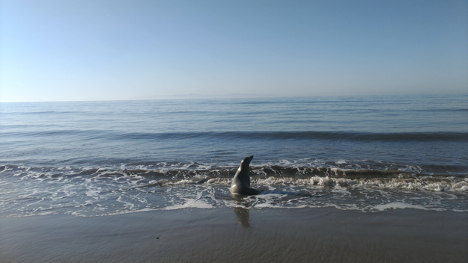Over the Edge.
by Phoebe Rogers
Peering over the edge of something momentous, though still indecipherable, I had been hesitating, stalling for the right reason or assurance to dive in. In October of 2019, I got the push that I was waiting for. Any story of how I was drawn to the River Advocacy Training School (RATS) Program would simply miss the mark lest it start with the sea lion that sent me over the edge.
It was the first term of the school year, and my best friend and I were taking a walk by the beach in Santa Barbara, where we go to University. I had arrived to campus this year deeply ruminating on how to act on the swelling and increasingly distracting urgency I felt toward stepping up and doing something (anything!) to move the climate crisis in a more stable direction. My Public Lands Policy class completely exploded my mind with new insights and imperatives on the massive importance of civic involvement in environmental issues and the formidable synergy of individuals converging on a shared passion.
Lingering down the beach back toward our house, stretching out the time before we had to bike off to class, we noticed a figure struggling in the wake. Walking with more urgency, as we approached it became clear that we were witnessing a seal lion– fighting to keep its balance in a soft tide. It was arching its head back in a disturbing posture, seemingly unthreatened by our increasing proximity, and looking straight at us without an ounce of trepidation or alarm. We knew something was very wrong with this animal.

There are a lot of things on the shores of comfort and certainty that may compel us to stay there– in my case, I had classes I should probably get to, someone else will call wildlife rescue. But I was frozen in a petrified m
oment of moral compulsion, looking this sea lion in the eye, knowing that time is wasted waiting for the river of action to open up and drag us in– sooner or later we have to decide to jump. To consciously situate ourselves in that movement of change– the forward flow toward transformation. In a flash of resolve, I called marine rescue and committed to wait with her for 3 hours, encouraging people and their dogs to keep distance until rescue arrived.
We found out later that she had domoic acid toxicosis- a horrible condition caused by toxic algae blooms that were occurring off our coast. The blooms are caused by a deadly combination of the warm water pockets moving down the Pacific Coast and traces of fertilizers that run into the oceans after heavy rain, encouraging the rapid growth of the algae. The sea lion’s suffering was directly attributable to the warming and pollution of oceans. I had never stared down climate change face to face until this day. Witnessing this animal, in such a poignant moment of vulnerability, forced me to confront my willingness to plunge into the rapid and system-shocking current the runs between a problem and its response.
 I sought out the RATS program because of how intentionally and tactfully the cohort was activated to effect positive change in their communities. I see policy change as a powerful, systemic tool for protecting our rivers and watersheds and was ardent to absorb as much as I could.
I sought out the RATS program because of how intentionally and tactfully the cohort was activated to effect positive change in their communities. I see policy change as a powerful, systemic tool for protecting our rivers and watersheds and was ardent to absorb as much as I could.
Being a RAT has taught me invaluable lessons about resiliency, and how to “jump-in” to things you feel timid about- like calling businesses and members you don’t know (yet) to engage them in environmental protection campaigns. When you have amazing people beside you, with indefatigable spirit for change, who also ground their advocacy in a foundation of love for our rivers, the current of collective action uplifts you and carries you aloft toward a more sustainable future for our rivers and environment.

